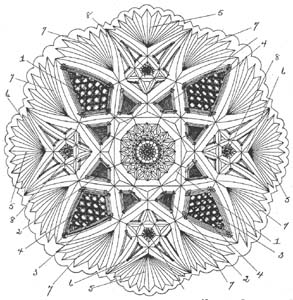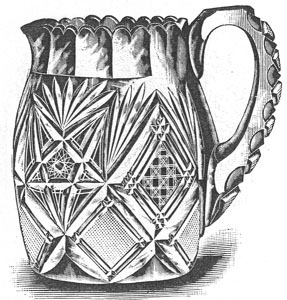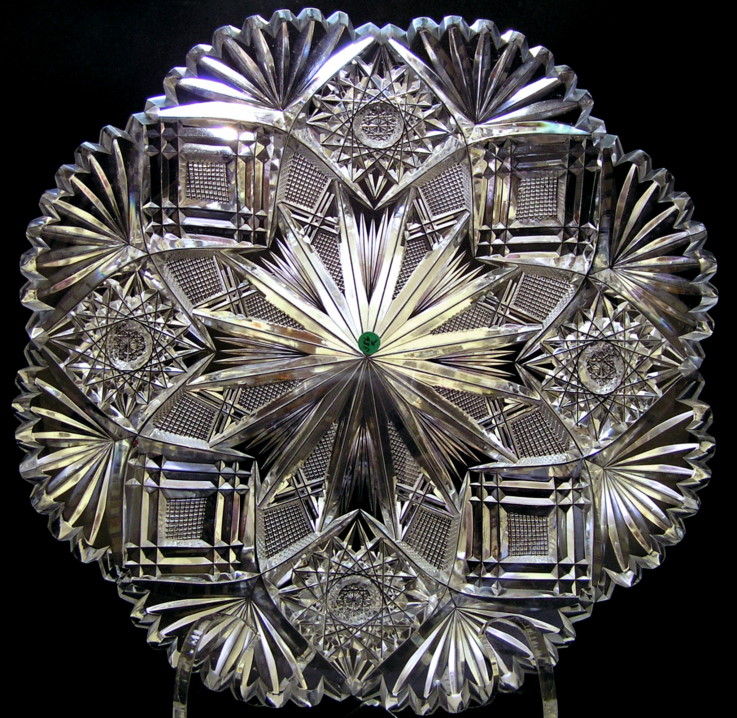

In Leigh Emmerson's informative account of the life of William C. Anderson the author refers to the "double mitering of small motifs" as a contribution made by Anderson that can be found in a series of design patents, beginning with the Florence pattern of 1889 and continuing through several successive patents. In fact, however, the mitering is single, not double, in the five Anderson patents of this period that have this feature. A sixth patent mentioned by Emmerson, the Fleur-de-Lis pattern of 1893, has both single and double mitering as can be seen in the following illustrations. The drawing on the left accompanied the patent application, while the drawing on the right is from a contemporary Libbey catalog. The latter clearly shows the difference between single and double mitering, the former enclosing quadrilaterals of strawberry (fine) diamonds, the latter enclosing quadrilaterals of cane variant.


Emmerson's error concerning mitering probably was made because of the difficulty in determining the actual number of miters present when this feature is drawn rather than photographed. It is ironic that, while drawings generally show patterns in more detail than do photographs -- especially given the state of photography at this time -- in this case if photographs were used in place of drawings the difference between single and double mitering would probably be more obvious. The problem of drawn miters is exacerbated by the fact that different draftsmen were employed at different times and their styles differ. Attempts by the draftsmen to render the mitering three-dimensional also contribute to the problem. The reader can readily appreciate Emmerson's problem and, at the same time, treat himself to eyestrain by examining the patent and catalog drawings of the patterns listed below.
Here are the five Libbey patents designed by Anderson that have single mitering and not double mitering as stated by Emmerson -- as shown by the patent drawings that can be viewed at the U. S. Patent and Trademark Office's Web site.
The list ends with the sixth pattern, Fleur-de-Lis, that, as mentioned above, has both types of mitering. The term "mitering" is, unfortunately, somewhat ambiguous because it is not clear exactly where the mitering is located. In this summary "mitering" is replaced with "framed" which is attached to the motif that is being acted upon (modified). Other writers have used terms such as outline, boundary, and fence. Again, note that only the cane variant in the Fleur-de-Lis pattern is double framed (i.e., double mitered).
The foregoing information was obtained by inspecting patent drawings and supplementing them with catalog drawings. In the real world the size of the item sometimes comes into play, resulting in single frames being replaced by double frames, and double frames by triple frames. Also, it should be noted that framing was not limited to Anderson at Libbey. Richardson used it in his Gem I pattern (pat. no. 24,875); Hill used double framing in his "Victoria" pattern (pat. no. 26,396); J. Hoare & Company frequently made use of both single and double framing; and one can find additional examples. It is reasonable, nevertheless, to conclude that the single and double framing introduced by William C. Anderson was a significant factor in the use of this motif-modifier by other glass cutters during the 1890s.
Updated 19 Aug 2002
Addendum (7 Apr 2004)
This is an actual example of the "strawberry diamonds, framed" motif (single, not double mitered) that is found in the center of Libbey's Kimberly pattern (1892). Note also the use of single framing on the small triangles that border this large hexagon (Image: Internet).
Addendum (25 Jun 2007)
Hill's "Victoria" pattern of 1896 is shown here as realized on a 8"D plate. Note th use of double frames to enclose quadrilaterials of strawberry (fine) diamonds). (Image: Private collection).
Pat. no. 19,053, Florence (1889): strawberry diamonds, framed
Pat.
no. 19,076, "Rhomb" (1889): uncut triangular areas, framed
Pat. no.
19,450, Stratford (1889): strawberry diamonds, framed (limited to the
central area)
Pat. no. 21,364, Kimberly (1892): strawberry diamonds,
framed
Pat. no. 22,098, Isabella (1893): triangular areas with
strawberry diamonds, framed on two sides
Pat. no. 22,433, Fleur-de-Lis
(1893): strawberry diamonds, framed; cane variant, double framed

